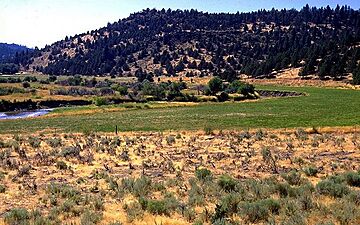Modoc Plateau facts for kids

The Modoc Plateau is a large, flat area of land in the northeastern part of California. It also stretches into parts of Oregon and Nevada. Imagine a huge, elevated table of land! About 1 million acres of the Modoc National Forest are found here. This plateau sits between the Medicine Lake Highlands to the west and the Warner Mountains to the east.
This land was shaped by volcanoes. It's like a giant table, sitting between 4,000 and 6,000 feet above sea level. Many cracks, called faults, run through it from north to south. You can find lakes, marshes, and slow-moving streams winding across the plateau.
The plateau is made of many layers of lava flows and tuff beds. These are rocks formed from ancient volcanic eruptions. You'll also see many small volcanic cones here. The area has cinder cones, flat areas with juniper trees, pine forests, and lakes that appear in different seasons. Scientists believe the Modoc Plateau formed about 25 million years ago. It's like a southern part of the much larger Columbia Plateau.
Plants and Animals of the Modoc Plateau
The Modoc Plateau is home to many different plants and animals. Its forests are filled with beautiful trees and provide shelter for wildlife.
Trees and Plants
The most common tree in the forests here is the Ponderosa Pine (Pinus ponderosa). This tall pine tree is easy to spot. Other trees you might see include the California Buckeye (Aesculus californica). There's also a special tree called the Modoc Cypress (Cupressus bakeri). These trees help make the plateau a green and lively place.
Wildlife and Habitats
The plateau is a great place for many animals to live. You can find large groups of Mule Deer (Odocoileus hemionus) roaming around. There are also Rocky Mountain Elk (Cervus canadensis) and Pronghorn (Antilocapra americana). Pronghorn are known for being the fastest land animals in North America!
The Modoc Plateau is also home to several herds of wild horses. These horses live freely across the land. To protect some of these animals and their homes, the Clear Lake National Wildlife Refuge and the Long Bell State Game Refuge are located on the plateau. These refuges help keep the natural environment safe for wildlife.
Waterways and Reservoirs
Water is very important to the Modoc Plateau. It shapes the land and supports all the life there.
Rivers and Basins
The northern part of the plateau is drained by the Lost River watershed. A watershed is an area of land where all the water drains into a single river or lake. In the southern parts of the plateau, water either collects in natural basins or flows into a large lake. This lake is called the Big Sage Reservoir. It sits right in the middle of Modoc County. These waterways are vital for the plants and animals living on the plateau.

